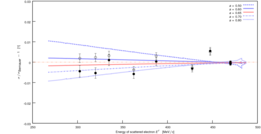Meeting No. 15
Proposal Jet ISR:
I am working on the proposal for the next ISR experiment. The proposal needs to be done next week.
I have run the simulation for the jet target, assuming 20uA, and 2mm thick target. The number
density was 1E19/cm2. Here are the results:
1.)  2.)
2.) 
Here is also the table with proposed kinematics and required times. To accomplish the
program we need approx 22days of beam-time:
RunPlanJetISR.pdf
Data analysis:
In the last past months I did several changed to the analysis in the attempt to
understand the first "elastic" point. These changes distorted also other parts of the
analysis. Hence, I had to recover from the changes and return to the status of
the Feb2016. The consensus is, that we leave elastic point out due to the problem with
numerics in the higher order corrections, when soft photon is very soft. However,
the radcorr factor is still needed! To many simulated events in the elastic line
could still distort the events in the tail via other types of losses. Hence, the
analysis we had at the beginning of the year was right!
The ultimate question is, how sensitive are our data really to the FFs. We are
aware that the change is small, because we are at very low Q2. However, are we
able to say something about the FF or are we dominated by the lepton diagrams?
Hence, I redid my analysis with with the dipole approximation instead of the
Bernauer parameterization. Turns out, that with the given statistics, we can
see approx. 2sigma effect in the tail region. However, with the given precision,
we can not distinguish between Bernauer and Pohl radius.
Following plot show the comparison of the dipole simulations with respect to the
Bernauer parameterization, together with the data. The full circles demonstrate
data with respect to Bernauer, empty circles show data with respect to dipole approx.
Elastic points were left out of the analysis. Data are normalized to the average
between second and third point!
3.) 
Following plot show the comparison of the dipole simulations with respect to the
standard dipole parameterization, together with the data. The full circles demonstrate
data with respect to Bernauer, empty circles show data with respect to dipole approx.
4.) 
I tried to qualify which of the curves we prefer. Therefore, I constructed the
most-likelihood function. It seems that the data prefer the dipole fit, with
smaller radius.
5.) 
Now it would be interesting to see, which quadratic fit (as used to
fit our data) is preferred. This will be the next step.
Important Question:
The Jet-ISR aims to measure CS with the same precision as shown above. Are we going
to be sensitive enough to say more about FFs?
Last modified 19.08.2016
 2.)
2.) 


